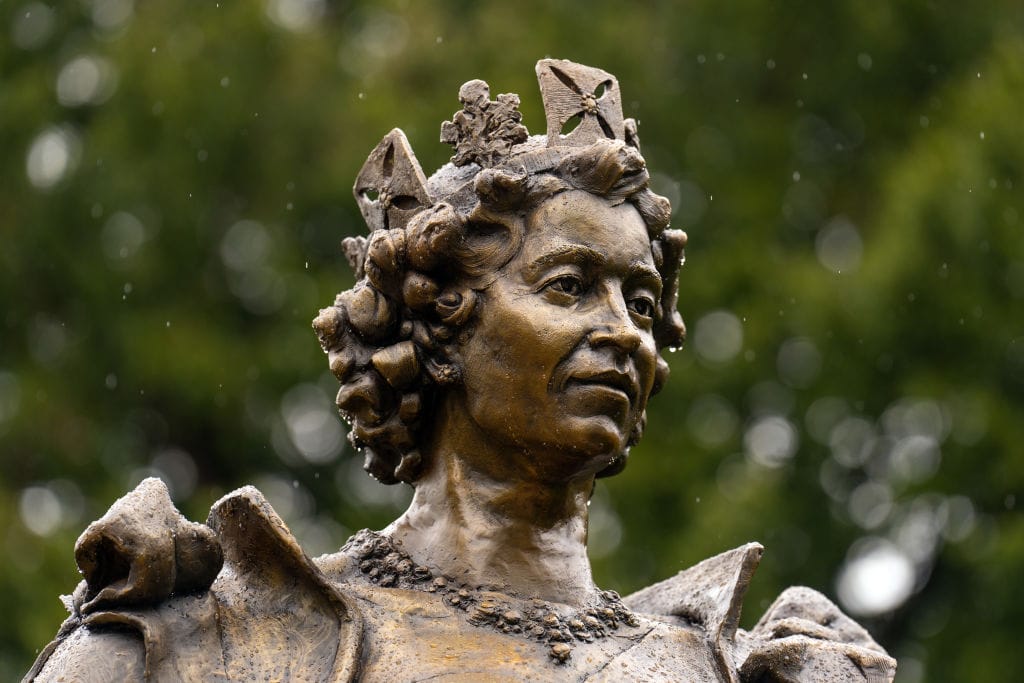
A great deal of people felt sorrow upon Queen Elizabeth II’s passing in 2022. She was adored by the public and the longest-reigning monarch in British history, having ruled for 70 years.
The late queen is now being honored with a monument that was recently unveiled, honoring her affection for her pet corgis!
The Queen’s new statue, together with her dogs
On Sunday, a 7-foot-tall bronze statue of Queen Elizabeth was unveiled in observance of the monarch’s 98th birthday.

In Oakham, England, the sculpture was made by artist Hywel Pratley and is situated close to the Oakham Library. It is Queen Elizabeth’s first ever permanent memorial.
Rutland City Council said that hundreds attended the unveiling. There was music from local school bands and bagpipers.
The most priceless feature of this new memorial is that the queen’s cherished Corgis pet is also depicted, immortalized in bronze by the monarch’s feet:

The city authority claims that local schoolchildren created the designs for the Corgi monuments.
In contrast to the many stern and imposing monuments of queens like Queen Victoria, Pratley stated he wanted the statue to portray the idea of Queen Elizabeth as “an almost motherly figure,” according to the New York Times.
During the unveiling, local dignitary Sarah Furness remarked, “What most of us remember about Queen Elizabeth is her warmth.” “We demonstrate Queen Elizabeth’s humanity by showcasing her affection for dogs.”

The statue’s creator claims that he intended it to be hospitable to onlookers. Pratley said, “We designed it with a bench you can sit on.” “And there’s a corgi you can pet, and I do believe that this will eventually become a selfie-encouraging statue.”
The Times reports that a number of Corgi owners brought their dogs to the unveiling, indicating that a large number of people have already visited the statue.
The history of Queen Elizabeth’s Corgis pet
For many years, the Queen’s corgis were an iconic aspect of her life and a solace during tough political and personal times. Fans all throughout the world were likewise pleased by the cute pets.
The first Corgi was acquired by the royal family in 1933 when Dookie, a dog owned by Elizabeth’s father and predecessor George VI (who was then the Duke of York), was brought home.

Dookie was reportedly extremely cantankerous, yet Elizabeth and him appeared to have a unique relationship.
Then, on her eighteenth birthday, the Queen received a Pembroke Welsh corgi of her own, named Susan.
Susan reportedly slipped under a rug in the royal carriage to disrupt the wedding of the Queen and her husband, Prince Philip, according to the BBC.
1959 saw Susan’s death at the age of almost fifteen. Her epitaph referred to her as “the faithful companion of the Queen,” and she was laid to rest at the royal estate of Sandringham House.
The Queen stated, “I had always feared losing her, but I am ever so thankful that her suffering was so mercifully brief.”
But Susan left quite the legacy; during the ensuing few decades, the Queen accumulated over thirty corgis, all descended from her original canine companion.
The Queen always had at least one corgi, and often had several at once, from 1933 until 2018. She traveled with the dogs in tow, and they resided in a designated “Corgi room” at Buckingham Palace with wicker beds. It is said that the Queen took care of them personally and baked them biscuits over the holiday season.

These canines undoubtedly received royal treatment and grew to represent the Queen throughout her life.
While Elizabeth valued the dogs greatly, Prince Philip apparently didn’t feel the same way. Like many others, she took great solace from the dogs, who served as a link to the simpler times in her early years due to their relationship with her late father and her upbringing.
According to Penny Junor, a royal biographer, “her corgis are hugely important to her.” Over time, they have become more intimate with her than any human has ever been. She has never been let down by the incredibly affectionate and devoted corgis.

It also makes sense that the Queen, who represents both Britain and the United Kingdom, would have a strong bond with a quintessential British dog. Wales, a member of the UK and a neighbor of England, is where corgis first originated. When corgis were adopted as royal dogs, the breed was rare in England; yet, the Queen had a major role in the globalization of the breed.
The Queen owned several “dorgis,” or corgis bred with daschshunds, in addition to purebred Pembroke Welsh Corgis.
When the corgis and dorgis appeared alongside Queen Elizabeth on the cover of Vanity Fair in 2016, they became well-known worldwide because to Annie Leibovitz’s photography. At the time, the dogs were Candy, Vulcan, Willow, and Holly.
A notable aspect of Queen Elizabeth’s reign and a significant aspect of her life were her corgis. Their inclusion in this first memorial statue of her seems so fitting.
Please tell this tale!
I Nearly Froze to Death at 8 Years Old Until a Homeless Man Saved Me—Today, I Accidentally Met Him Again

I never thought I’d see him again. Not after all these years. Not after he saved my life that night in the snowstorm and vanished without a trace. But there he was, sitting in the subway station with his hands outstretched for change. The man who once saved me was now the one who needed saving.
For a moment, I just stood there, staring.
It reminded me of that very day. Of the biting cold, of my tiny, frozen fingers, and of the warmth of his rough hands guiding me to safety.

A little girl standing in forest | Source: Midjourney
I had spent years wondering who he was, where he had gone, and if he was even still alive.
And now, fate had placed him right in front of me again. But could I truly help him the way he once helped me?
***
I don’t have many memories of my parents, but I do remember their faces.
I clearly remember the warmth in my mother’s smile and the strength in my father’s arms. I also remember the night it all changed.
The night I learned they weren’t coming back.

A girl standing by a window | Source: Midjourney
I was only five years old when they died in a car accident, and back then, I didn’t even fully understand what death meant. I waited by the window for days, convinced they would walk through the door at any moment. But they never did.
Soon, the foster system became my reality.
I bounced from shelters to group homes to temporary families, never truly belonging anywhere.
Some foster parents were kind, others were indifferent, and a few were downright cruel. But no matter where I ended up, one thing remained the same.
I was alone.
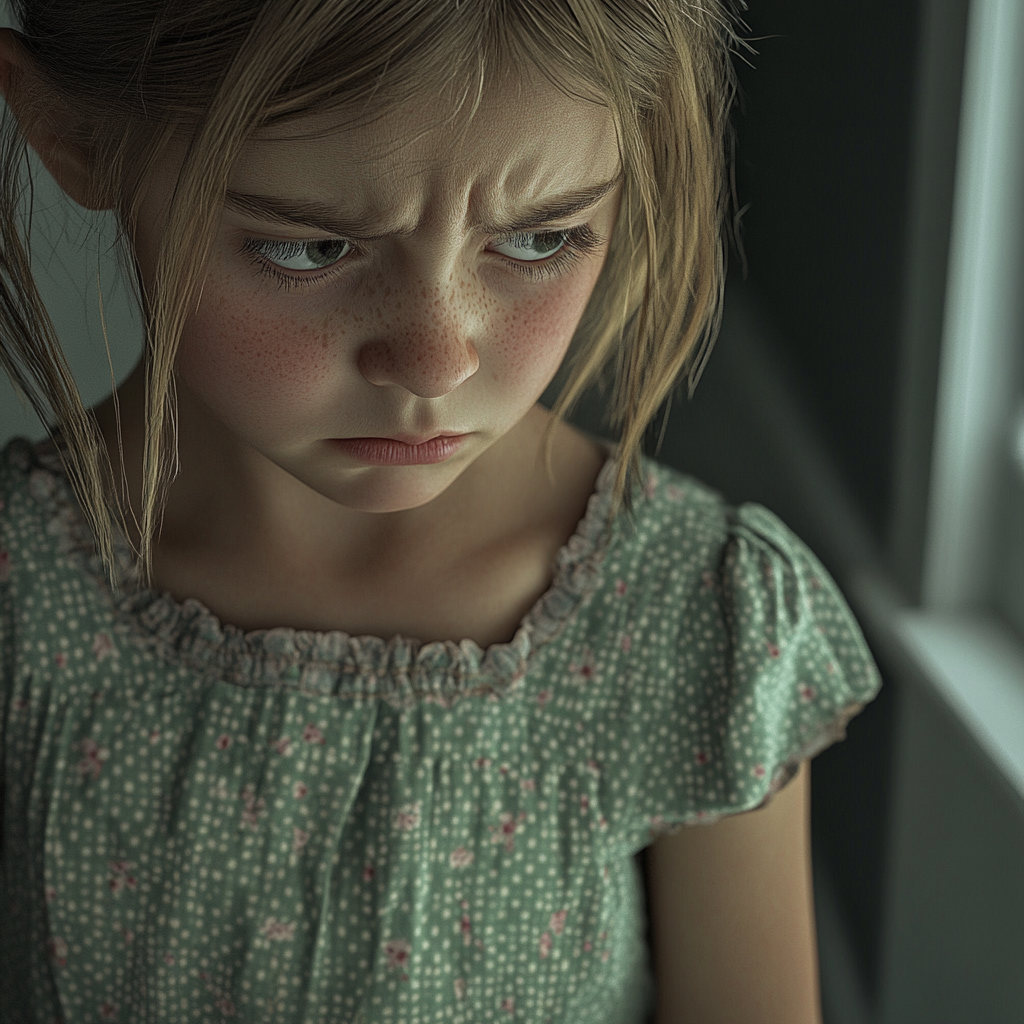
An upset girl | Source: Midjourney
Back then, school was my only escape.
I buried myself in my books, determined to build a future for myself. I worked harder than anyone else, pushing past the loneliness and the uncertainty. And it paid off.
I earned a grant for college, then clawed my way through medical school, eventually becoming a surgeon.
Now, at 38, I have the life I fought for. I spend long hours at the hospital, performing life-saving operations, and barely stopping to catch my breath.
It’s exhausting, but I love it.

Surgeons in an operation theatre | Source: Pexels
Some nights, when I walk through my sleek apartment, I think about how proud my parents would be. I wish they could see me now, standing in an operating room, making a difference.
But there’s one memory from my childhood that never fades.
I was eight years old when I got lost in the woods.
It was a terrible snowstorm, the kind that blinds you, the kind that makes every direction look the same. I had wandered too far from the shelter I was staying in.
And before I knew it, I was completely alone.

A girl standing in the woods during a snowstorm | Source: Midjourney
I remember screaming for help. My tiny hands were stiff with cold, and my coat was too thin to protect me. I was terrified.
And then… he appeared.
I saw a man wrapped in layers of tattered clothing. His beard was dusted with snow, and his blue eyes were filled with concern.

A man standing in the woods | Source: Midjourney
When he found me shivering and terrified, he immediately scooped me up in his arms.
I remember how he carried me through the storm, shielding me from the worst of the wind. How he used his last few dollars to buy me hot tea and a sandwich at a roadside café. How he called the cops and made sure I was safe before slipping away into the night, never waiting for a thank you.
That was 30 years ago.
I never saw him again.
Until today.

People at a train station | Source: Pexels
The subway was packed with the usual chaos.
People were rushing to work while the street musician did his thing in the corner. I was exhausted after a long shift, lost in thought, when my eyes landed on him.
At first, I wasn’t sure why he looked familiar. His face was hidden beneath a scruffy gray beard, and he was wearing tattered clothes. His shoulders were slumped forward as if life had worn him down.
As I walked toward him, my gaze landed on something very familiar.
A tattoo on his forearm.
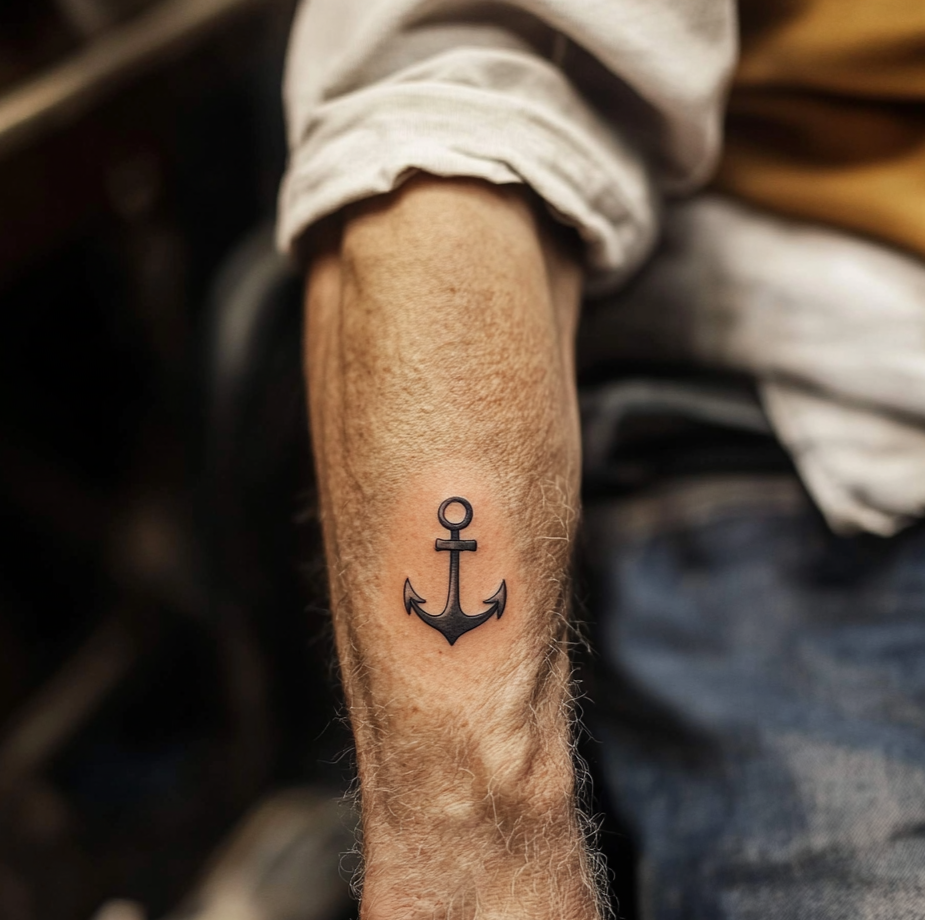
An anchor tattoo | Source: Midjourney
It was a small, faded anchor that immediately reminded me of the day I got lost in the woods.
I looked at the tattoo then back at the man’s face, trying my best to remember if it was really him. The only way I could confirm it was by talking to him. And that’s what I did.
“Is it really you? Mark?”
He looked up at me, trying to study my face. I knew he wouldn’t recognize me because I was just a child the last time he saw me.

A man sitting at a subway station | Source: Midjourney
I swallowed hard, trying to keep my emotions in check. “You saved me. Thirty years ago. I was eight years old, lost in the snow. You carried me to safety.”
That’s when his eyes widened in recognition.
“The little girl…” he said. “In the storm?”
I nodded. “Yes. That was me.”
Mark let out a soft chuckle, shaking his head. “Didn’t think I’d ever see you again.”

A man smiling | Source: Midjourney
I sat down next to him on the cold subway bench.
“I never forgot what you did for me.” I hesitated before asking, “Have you been… living like this all these years?”
He didn’t answer right away. Instead, he scratched his beard and looked away. “Life has a way of kicking you down. Some people get back up. Some don’t.”
At that point, my heart broke for him. I knew I couldn’t just walk away.
“Come with me,” I said. “Let me buy you a meal. Please.”
He hesitated, his pride keeping him from accepting, but I wouldn’t take no for an answer.
Eventually, he nodded.

A man talking to a woman | Source: Midjourney
We went to a small pizza place nearby, and the way he ate told me he hadn’t had a good meal in years. I blinked back tears as I watched him. No one should have to live like this, especially not someone who once gave everything to help a lost little girl.
After dinner, I took him to a clothing store and bought him warm clothes. He protested at first, but I insisted.
“This is the least I can do for you,” I told him.
He finally accepted, running a hand over the coat as if he had forgotten what warmth felt like.
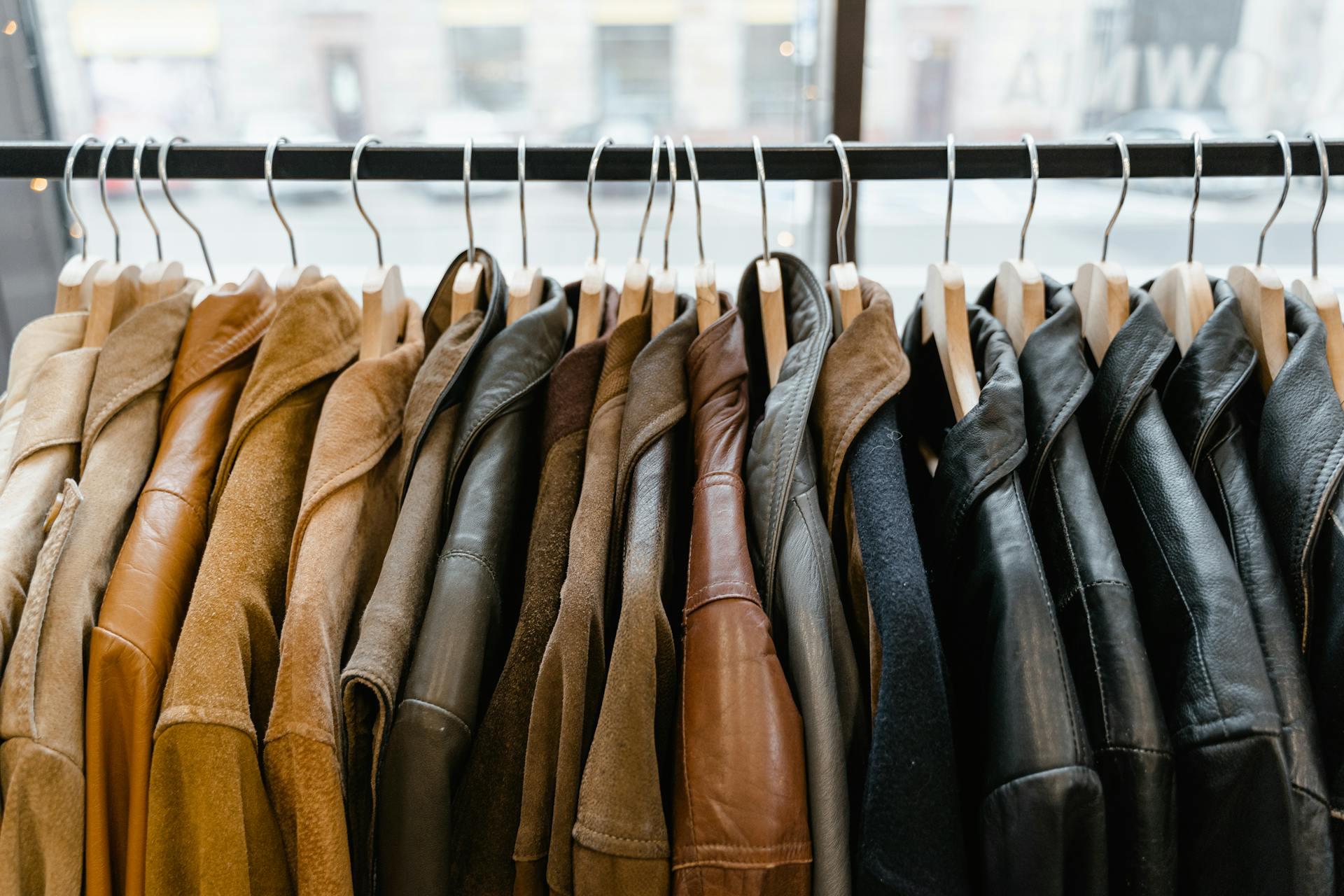
A rack with coats and jackets | Source: Pexels
But I wasn’t done helping him yet.
I took him to a small motel on the outskirts of the city and rented a room for him.
“Just for a while,” I assured him when he hesitated. “You deserve a warm bed and a hot shower, Mark.”
He looked at me with something in his eyes that I couldn’t quite comprehend. I think it was gratitude. Or maybe disbelief.
“You don’t have to do all this, kid,” he said.
“I know,” I said softly. “But I want to.”
The next morning, I met Mark outside the motel.

A motel sign | Source: Pexels
His hair was still damp from the shower, and he looked like a different man in his new clothes.
“I want to help you get back on your feet,” I said. “We can renew your documents, get you a place to stay long-term. I can help.”
Mark smiled, but there was sadness in his eyes. “I appreciate that, kid. I really do. But I don’t have much time left.”
I frowned. “What do you mean?”
He exhaled slowly, looking out toward the street. “Doctors say my heart’s giving out. Not much they can do. I feel it, too. I won’t be around much longer.”

A man talking to a woman | Source: Midjourney
“No. There has to be something—”
He shook his head. “I’ve made peace with it.”
Then he gave me a small smile. “There’s just one thing I’d love to do before I go. I want to see the ocean one last time.”
“Alright,” I managed to say. “I’ll take you. We’ll go tomorrow, okay?”
The ocean was about 350 miles away, so I had to take a day off from the hospital. I asked Mark to come over to my place the next day so we could drive there together, and he did.
But just as we were about to leave, my phone rang.

A woman using her phone | Source: Pexels
It was the hospital.
“Sophia, we need you,” my colleague said urgently. “A young girl just came in. Severe internal bleeding. We don’t have another available surgeon.”
I looked at Mark as I ended the call.
“I—” My voice caught. “I have to go.”
Mark gave me a knowing nod. “Of course you do. Go save that girl. That’s what you were meant to do.”
“I’m sorry,” I said. “But we’ll still go, I promise.”
He smiled. “I know, kid.”

A man smiling while talking to a woman | Source: Midjourney
I rushed to the hospital. The surgery was long and grueling, but it was successful. The girl survived. I should have felt relieved, but all I could think about was Mark.
As soon as I was done, I drove straight back to the motel. My hands trembled as I knocked on his door.
No answer.
I knocked again.
Still nothing.
A sinking feeling settled in my stomach as I asked the motel clerk to unlock the door.
When it opened, my heart shattered.
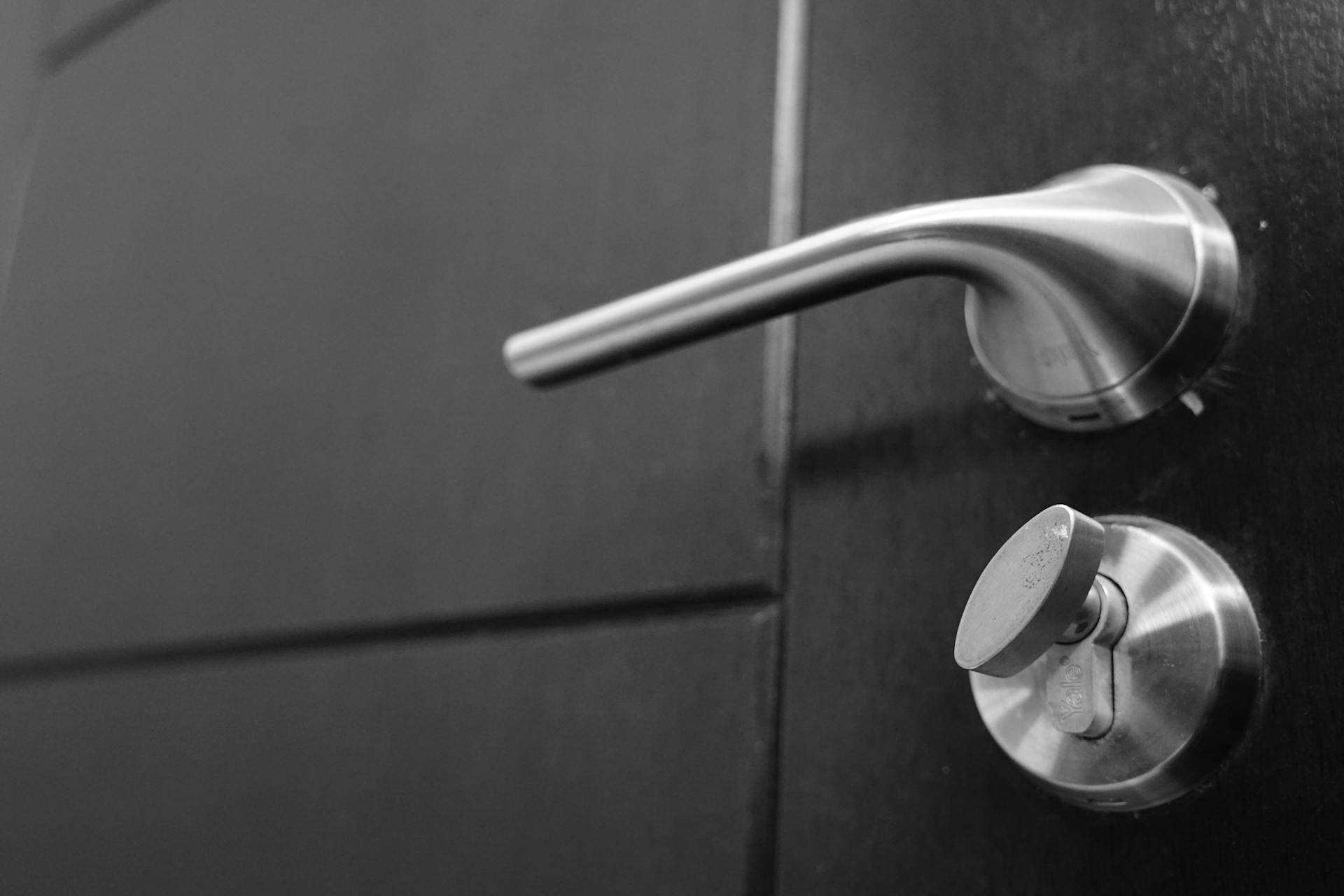
A doorknob | Source: Pexels
Mark was lying on the bed, his eyes closed, his face peaceful. He was gone.
I stood there, unable to move. I couldn’t believe he was gone.
I had promised to take him to the ocean. I had promised.
But I was too late.
“I’m so sorry,” I whispered as tears streamed down my cheeks. “I’m so sorry for being late…”
***
I never got to take Mark to the ocean, but I ensured he was buried by the shore.

Waves on the shore at sunset time | Source: Pexels
He’s gone from my life forever, but one thing he has taught me is to be kind. His kindness saved my life 30 years ago, and now, I carry it forward.
In every patient I heal, every stranger I help, and every problem I try to solve, I carry Mark’s kindness with me, hoping to give others the same compassion he once showed me.
This work is inspired by real events and people, but it has been fictionalized for creative purposes. Names, characters, and details have been changed to protect privacy and enhance the narrative. Any resemblance to actual persons, living or dead, or actual events is purely coincidental and not intended by the author.
The author and publisher make no claims to the accuracy of events or the portrayal of characters and are not liable for any misinterpretation. This story is provided “as is,” and any opinions expressed are those of the characters and do not reflect the views of the author or publisher.




Leave a Reply